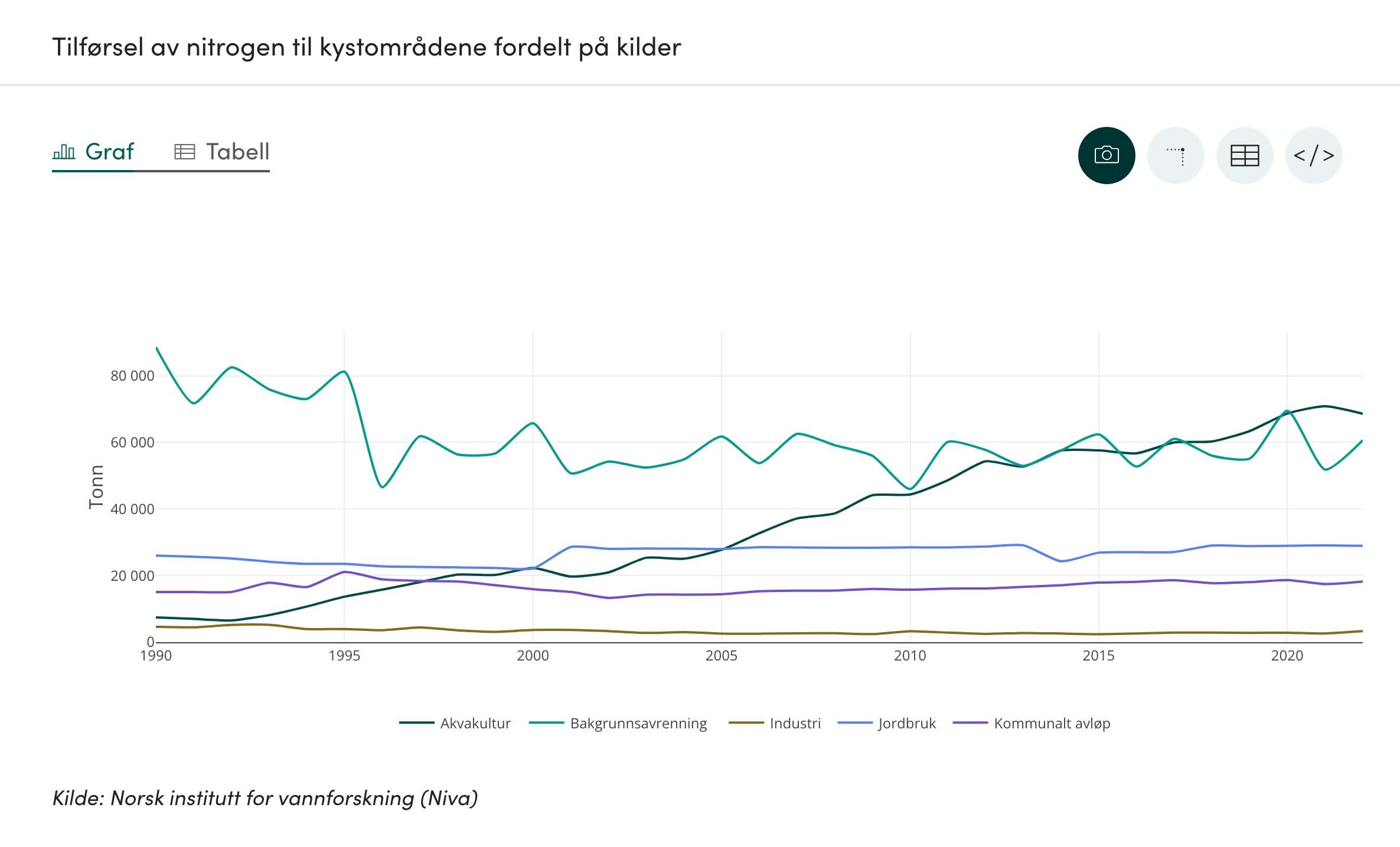Effluent emissions from open-pen fish farming
“[F]ish farming is by far the largest source of anthropogenic emissions of nutrients and organic particles in our coastal areas, according to an overview from the Norwegian Environment Agency.” 26 March, 2023
(The Norwegian Environment Agency is a vital governmental body in Norway, responsible for overseeing the country's environmental policies and regulations.)
The graphic is based on information given in the report Underwater Cages, Parasites and Dead Fish. Why a Moratorium on Scottish Salmon Farming is Imperative by OneKind and Compassion in World Farming.
The Norwegian Environment Agency states:
“Fish farming has contributed to steadily increasing inputs of phosphorus, nitrogen and copper to the Norwegian Sea over the past two decades.”
The Norwegian Institute of Marine Research publishes data for emissions from open-open salmon farming
From this data, the pollution for the projected salmon production in Falklands waters can be calculated
-
Based on Norwegian data (see quote below), between 86,395 tonnes and 101,552 tonnes of particulate organic material would be released annually for the projected 200,000 tonnes of salmon production in Falkland waters.
Quoting the Norwegian Institute of Marine Research’s Risk Report Norwegian fish farming 2024:
“Farmed fish in Norway is mainly produced in open cage facilities and organic particles are released directly into the environment in the form of faeces from the fish and feed that is not eaten.”
“Emissions of organic compounds can be calculated according to a mass balance budget based on modern feed composition, where estimated emissions of faecal matter are calculated at 29.2% and estimated feed waste at 5-11% of the feed quantity. The total feed consumption in 2023 was calculated at 2,033,566 tonnes (figures from the Directorate of Fisheries). Based on the mass balance budget, the total emissions are calculated to be between 695,480 and 817,494 tonnes of organic material from Norwegian food fish farms.”
-
Based on the model quoted below, 200,000 tonnes of farmed salmon would yield an annual discharge of 7,660 tonnes of dissolved nitrogen and 1,020 tonnes of dissolved phosphorus into Falklands waters.
Quoting from the Norwegian Institute of Marine Research’s Risk Report Norwegian fish farming 2024:
“When salmon feed in the facilities, dissolved nitrogen and phosphorus will be released via the gills and also a smaller proportion in the form of urea. The production of salmon in the last year (November 2022-October 2023) gives estimated emissions of 61,671 tonnes of dissolved nitrogen and 8,191 tonnes of dissolved phosphorus (TEOTIL). […] The discharge amount of dissolved nutrient salts will be proportional to fish production, and we have used calculations with the TEOTIL model here, which estimates a discharge of 38.4 kg of dissolved nitrogen and 5.1 kg of dissolved phosphorus per tonne of salmon produced.”
-
● Quoting from the Risk Report Norwegian fish farming 2024 by the Norwegian Institute of Marine Research:
“It is well documented that an increased concentration of dissolved nutrient salts (dissolved nitrogen and phosphorus) can produce undesirable environmental effects in marine environments.”
“It is also well known that macroalgal communities can respond quickly to additional nitrogen supply with reduced biodiversity and increased occurrence of opportunistic green algae at the expense of perennial habitat-building species such as seaweed and kelp.”
“Changes in macroalgae communities due to increased nutrient salt values that result in a high incidence of opportunistic species are known from several places in the world and can also have consequences for wildlife living in shallow areas. The consequence of high phytoplankton production can be more serious as oxygen conditions and animal life on the bottom can also be affected.”
● Quoting from a report by the Tasmanian Independent Science Council:
Installation of nets and other infrastructure reduces water circulation, particularly where the bases of salmon pens are located near the sea bed.
Fish excretia, uneaten food and net-cleaning operations (removal of biofouling) pollute coastal waters with organic and nutrient pollution.
When too many salmon are grown in areas with limited flushing, this pollutes sediments in the vicinity of the pens and also causes algal blooms that reduce water clarity and smother nearby seagrass beds and reefs.
Pens have become larger over time and there is no regulatory limit on the number of pens or tonnage of fish that can be grown on a given lease.”
-
Quoting the Norwegian Institute of Marine Research’s Risk Report Norwegian fish farming 2024:
“The production of salmon in the last year (November 2022-October 2023) gives estimated emissions of 61,671 tonnes of dissolved nitrogen and 8,191 tonnes of dissolved phosphorus (TEOTIL). By comparison, approximately 48,000 tonnes of nitrogen and 2,600 tonnes of phosphorus are released into the sea annually from agriculture, sewage and land-based industry.”
These graphs, published by the Norwegian Environment Agency, show that aquaculture (which in Norway is predominantly open-pen salmon farming) is the only source where emissions have been rising over the last three decades
Phosphorus emissions to coastal areas by source – only emissions from fish farming have risen in the last decades
KEY:
Dark green = aquaculture
Turquoise = general run-off
Brown = land-based industries
Blue = agriculture
Purple = municipal sewage
Nitrogen emissions to coastal areas by source – only emissions from fish farming have risen in the last decades
KEY:
Dark green = aquaculture
Turquoise = general run-off
Brown = land-based industries
Blue = agriculture
Purple = municipal sewage




